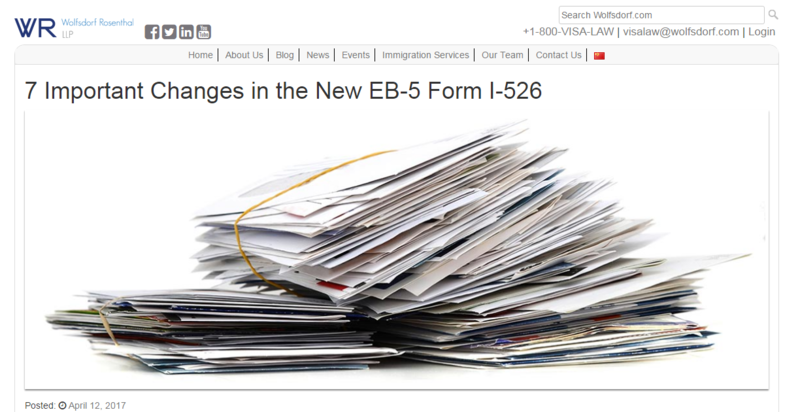7 Important Changes in the New EB-5 Form I-526
USCIS officially released the new edition of Form I-526, Immigrant Petition by Alien Entrepreneur, which must be used starting June 9, 2017. The new edition helps implement the USCIS focus on transparency and integrity in the EB-5 program. The form increases from 3 to 13 pages and substantially adds to the important information required by investors and regional centers.
Here are 7 features to understand about the new Form I-526.
- 5 years of Employment History and 5 years of Physical Addresses: Although this information is disclosed on Form DS-260 or Form G-325A after I-526 approval, USCIS is requesting this information earlier in the process. Applicants should ensure that the information is consistent with that listed on prior visa applications and in the source of funds documentation.
- Type of Investment and required capital: Question 7 asks petitioners whether the investment falls in an “Upward Adjustment Area,” which is not currently defined by existing regulations. The new version forces petitioners to choose whether the New Commercial Enterprise (NCE) and Job Creating Enterprise (JCE), if applicable, are located in a rural area or a high unemployment area as qualification for a Targeted Employment Area.
- Income and Net Worth: Petitioners are now asked questions about the type of investment contributed to the NCE. Some have posited whether this information was meant to refer to an NCE attempting to qualify as a troubled business, however, the heading clearly requests “Your Investment and Your Income.” Petitioners are also asked for their total gross income, net income, and net worth both currently and at time of investment. For many petitioners, this information is unnecessary to determine the legitimate source of funds.
- Composition of Investment: Perhaps the most confusing portion of the new version requires the petitioner to identify the composition of investment. This question exacerbates USCIS’s confusing guidance regarding the definition of capital. Although most petitioners invest cash into a U.S. business account for the NCE (Part 2, Box 9), it may be in the form of “debt financing” (under current USCIS interpretation) (Box 12), or in the form of stock or equity purchases (Box 13). Furthermore, petitioners are given the option to list the value of property transferred from abroad, with no option for property transferred from the U.S. (Box 11). It is unclear how a petitioner in one of these scenarios should answer this question.
- Source of Investment Capital: The new form requires petitioners to specify the source of investment capital. Again, indebtedness is listed as an option despite the many public debates within the industry as to the true definition of this term. Petitioners are in the awkward position of answering this question under different interpretations.
- Information about the NCE: Petitioners must list all owners and their percentage of ownership in the NCE and whether they are applying for EB-5 benefits. However, this information is not static and will be outdated as each investor files a new I-526 petition for the project.
- Amount of Capital Derived from Non-EB-5 Investors: This question does not include capital a project may raise through debt or other financing options and therefore, does not provide accurate information. It also does not specify whether it is asking for capital derived by the NCE, JCE, or both.
With this additional information, we hope that USCIS will be able to adjudicate I-526 petitions more expeditiously and that the information will help create more transparency in the program. This form represents one big step forward in reforming the program and is exactly the correct approach. Fix the problems and don’t throw the baby out with the bathwater. This program has brought over $21 billion in new capital since Fiscal Year 2014 and hundreds of thousands of direct and indirect jobs. Hopefully this is one giant step towards improving the program.
However, the new information requirements are far more strenuous for both petitioners and regional centers. What consequences will there be if a petitioner answers a question incorrectly due to the confusing nature of certain questions? Investors, regional centers, and their attorneys must carefully review the information provided on the form as incorrect or inconsistent information could have serious consequences.
Mentions
Securities Disclaimer
This website is for informational purposes only and does not constitute an offer or solicitation to sell shares or securities. Any such offer or solicitation will be made only by means of an investment's confidential Offering Memorandum and in accordance with the terms of all applicable securities and other laws. This website does not constitute or form part of, and should not be construed as, any offer for sale or subscription of, or any invitation to offer to buy or subscribe for, any securities, nor should it or any part of it form the basis of, or be relied on in any connection with, any contract or commitment whatsoever. EB5Projects.com LLC and its affiliates expressly disclaim any and all responsibility for any direct or consequential loss or damage of any kind whatsoever arising directly or indirectly from: (i) reliance on any information contained in the website, (ii) any error, omission or inaccuracy in any such information or (iii) any action resulting therefrom.




